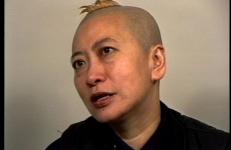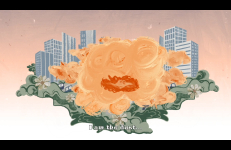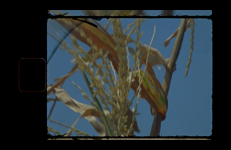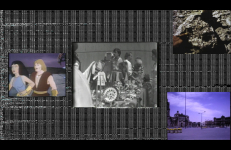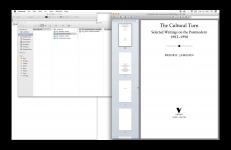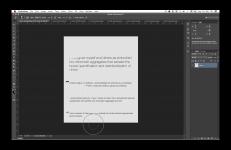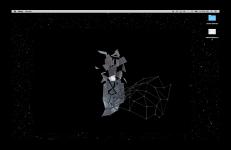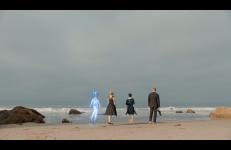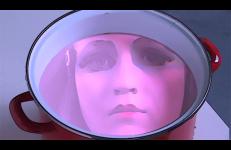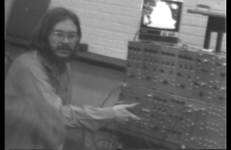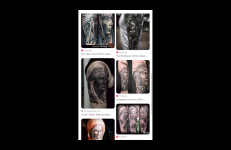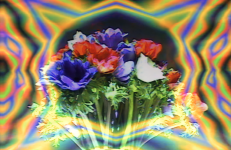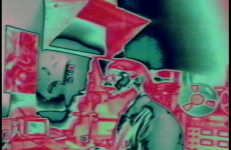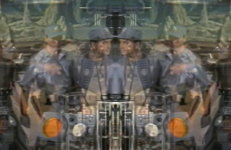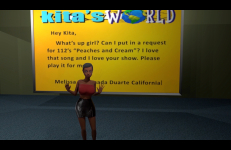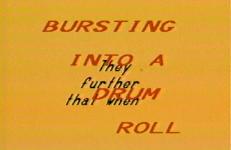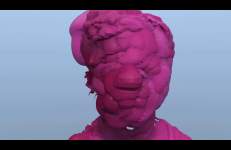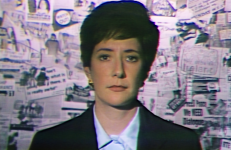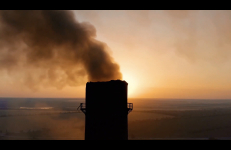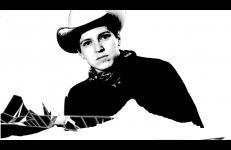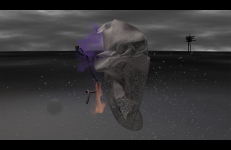Taiwanese artist Shu Lea Cheang (b. 1954) tackles conceptions of racial assimilation in American culture, examining the political underbelly of everyday situations that affect the relationship between individuals and society.
Technology
China, Beijing, I Love You! is an animated film about extraction of nickel and cobalt along China's Maritime Silk Road. The film focuses on the character of NICKEL DUST who is exiled from her home in Sulawesi Island due to nickel excavations there. On the other side of the world, in the Democratic Republic of Congo, cobalt is being extracted by artisanal miners. Both nickel and cobalt are the main components of batteries used in Electric Vehicle(EV) and mobile phones.
This is the vision from the “chinampas", the hectic life in the floating gardens, an ancestral system of audiovisual planting.
Colonial Transfer vindicates the eidetic chasm that produced the arrival of television in the cinema as well as the absorption, transduction and digital expansion of television and historical film archives, all linked by the negentropic outburst of a source code in trance. This is the state of ever-expanding media landscape in the post-covid quarantine. Our state of space-time.
Constituting an Outside (Utopian Plagiarism) is part one of Zach Blas's Contra-Internet Inversion Practice series. Contra-Internet Inversion Practice confronts the transformation of the internet into an instrument for state oppression and accelerated capitalism.
Social Media Exodus (Call and Response) is part two of Zach Blas's Contra-Internet Inversion Practice series. Contra-Internet Inversion Practice confronts the transformation of the internet into an instrument for state oppression and accelerated capitalism. Invoking a practice of utopian plagiarism, Contra-Internet Inversion Practice experiments with queer and feminist methods to speculate on internet futures and network alternatives.
Modeling Paranodal Space is part three of Zach Blas's Contra-Internet Inversion Practice series. Contra-Internet Inversion Practice confronts the transformation of the internet into an instrument for state oppression and accelerated capitalism. Invoking a practice of utopian plagiarism, Contra-Internet Inversion Practice experiments with queer and feminist methods to speculate on internet futures and network alternatives.
Contra-Internet: Jubilee 2033 is a re-imagining of scenes from filmmaker Derek Jarman’s 1978 queer punk film Jubilee, starring Susanne Sachsse and Cassils. Contra-Internet: Jubilee 2033 follows author Ayn Rand (Susanne Sachsse) and members of her Collective, including economist Alan Greenspan, on an acid trip in 1955. Guided by an artificial intelligence named Azuma, they are transported to a dystopian future Silicon Valley.
County Down is a cross-platform, episodic, digital video, exploring an epidemic of psychosis among the adults in a gated community, coinciding with a teenage girl’s invention of a designer drug. A rave-culture period-piece that harnesses the unwarranted optimism of the 1990s, County Down presents a society so obsessed with novelty and consumerism that it euphorically sews the seeds of its own destruction. Tracking the genesis of our current political climate, the ensemble cast banks on cultural appropriation and a constant din of micro-aggressions.
In this hour-long video, Dan Sandin demonstrates and explains in detail on modules of the Sandin Image Processor. Beginning with a playful and amateurish set up segment, Dan introduces his new invention, which he hints will be duplicated by Phil Morton shortly.
The likeness of a relative of the filmmaker surfaces as a tattoo on the arm of a Ukrainian soldier. A U.S. Army post in Oklahoma, built to fight Kiowa and Apache, is rededicated to aid in the fight against Putin’s own Western expansion. In Dau:añcut (Moving Along Image), Adam Piron explores the contradictions of colonialism and anti-settler solidarity across time and geography and in the muddled spaces of TikTok, where representations of Indigenous peoples are caught up in the ongoing and increasingly rapid circulation of images.
Dead Body Pose absurdly touches the contemporary bubble, encapsulating both connectivity and spirituality, a connection fueled by the global capitalistic consumption of the self. The more we are in the connectivity loop, the more thirsty we are for spirituality and assign it "a time slot". In the video, the artist performs the yoga rest pose Shavasana (dead body pose) as computer cursors come out of her body cavities and connect to their own spirituality together with her chakra affirmations.
This film is a recording of a live signal analog video/audio synthesizer performance with a voiced narration made in collaboration with an AI program. A speculative machine guided psychedelic broadcast of an astral floral projection. A fictional telepathic transmission that saturates the boundaries of perception with interlacing signals of interconnected consciousness.
— Les LeVeque
Dan Sandin demos the Digital Image Colorizer, a digital module that was part of the analog Image Processor.
Doubling Forbidden Planet is a feature length reedit of the 1956 science fiction film Forbidden Planet. This re-edit was produced in 2003 using a DIY apparatus of sequenced analog security system switchers, circuits and VHS players captured into a computer. The semi rhythmic and overlapping cuts produced by the switchers generated fragmented movement, dialogue, and soundtrack. Forbidden Planet’s soundtrack was made by Bebe and Louise Baron.
Dream Nightmare is from Martine Syms’ Kita’s World series. Kita enacts the performances of everyday life in a hyper-digitized world. The character’s roles range from meditation guru to cultural commentator, and she speaks directly to questions of consciousness within the systems of labor, race, technology, and institutional failure. To the cognitive dissonance of Siri mishearing her speech, to the terror of (mis)representation, to the instinct to reconnect with nature.
Earthglow is a poem written for the character generator and switcher that conveys a writer's internal dialogue through both subtle and dramatic color changes and through movement, size, and placement of words. The ambient soundtrack evokes the confluence of past and present perceptions.
A billboard looming over the 5 Freeway advertised a mortuary called “Eternal Valley.” In Green Valley, California, the road stops, eroded and dysfunctional, but continues to be nothing other than a road.
Camera: Ramzi Hibri, Matthew Lax
Edit: Matthew Lax
Extractions parallels resource extraction with the booming child apprehension industry. As the filmmaker reviews how these industries have affected her, she reflects on having her own eggs retrieved and frozen to make an Indigenous baby.
Facial Weaponization Communiqué: Fag Face protests against biometric facial recognition — and the inequalities these technologies propagate — by proposing the creation of “collective masks” that are modeled from the aggregated facial data of many faces, resulting in amorphous masks that cannot be detected as human faces by biometric facial recognition technologies.
Broadcasters across Ireland and Britain have entered into a blackout strike. The workers are transmitting a programme bringing censored voices back onto the airwaves.
"In the late 1980s, as violence continues in the north of Ireland, censorship is increasingly being enforced on British and Irish television. In response, broadcasters have entered into a blackout strike, occupying several stations and transmitting a programme bringing censored voices back onto the airwaves."
Found-footage video about the destruction of the environment by man-made forces.
"i am very grateful that my 鬼鎮 (Ghosttown) series has shown internationally over the last couple years and is recognized by viewers, reviewers, critics, and curators as doing decolonizing work as a feminist project that queers and glitches the Western genre. 鬼鎮 (Ghosttown) questions the quintessentially American Western in the forms of experimental films and games that are made from glitches and noise, pushing boundaries of legibility and tipping over threshold states of stability.
A buoyant character struggles with hazards in a cloudy gray environment in this animation inspired by the Dylan Thomas poem Lie Still, Sleep Becalmed. The look of the entire animation is shades of gray.
Fragments of Motion Capture data from two dancers were used to drive physical simulations of cloth, smoke, particles and fluids along with geometry for all the 4 “characters.”
Dancers: Michael Walsh and Maribeth Maxa
Heliocentric uses timelapse photography and astronomical tracking to plot the sun's trajectory across a series of landscapes. The entire environment seems to pan past the camera whilst the sun stays in the center of each frame, enabling us to gauge the earth's rotation and orbit around the sun. As the sun's light becomes disrupted by passing weather conditions and the environment through which we encounter it, it audibly plays them as if it were a stylus.




